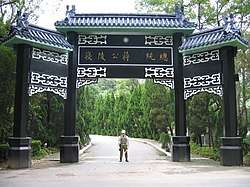|
Tai tou
 Tai tou (Chinese: 抬頭; lit. 'shift/lift head') is a typographical East Asian expression of honor.[1] It can be divided into two forms, Nuo tai and Ping tai.[example needed] Nuo tai (Example of such a space used before the word '領袖', here referring to Chiang Kai-shek) Nuo tai (Chinese: 挪抬, literally "move and shift") is a typographical device used in written Chinese to denote respect for the person being mentioned. It leaves a full-width (1 character wide) space before the first character of the person; it can be represented as Unicode character U+3000 IDEOGRAPHIC SPACE. This is often used in formal writing before using pronouns such as 貴 (guì, literally "precious, expensive", or "noble") to show respect. This is also sometimes still used in Taiwan for important officials, such as Chiang Kai-shek and Sun Yat-sen, although this practice has gradually fallen out of favor. [example needed] Examples(reading left to right)
Ping taiPing tai (Chinese: 平抬, literally "level shift") is another form. The way to express the respect is to shift the name of person directly to the head of the next line. This is now considered old-fashioned, and when it was used it was usually seen in documents sent between emperor and ministers when the minister mentioned the emperor. [example needed] Dan taiDan tai (Chinese: 單抬, literally "single shift") is an archaic form where the shifted phrase is moved to a new line and begins one character above a normal line. Traditionally, this is used when the recipient of the letter is addressed. Shuang tai Shuang tai (Chinese: 雙抬, literally "double shift") as above, but two characters above a normal line. This is used to denote respect for the recipient's parents and other elders. In official texts, this is used when the words emperor (帝) and empress (后) appear. San taiSan tai (Chinese: 三抬, literally "triple shift") as above, but three characters above a normal line; since Chinese writers customarily leave a margin of two characters for tai tou from the paper border, a san tai would require the first character to appear outside of the page borders. Such a practise is used for characters denoting the divine, such as Heaven, Earth, and deceased ancestors (天, 地 and 祖宗). References
|